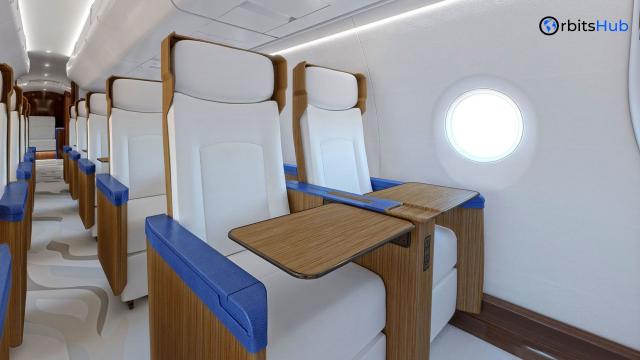
Table of Contents
Imagine slicing through the sky at unimaginable speeds, cutting Travel times in half and shrinking the world further. This isn’t science fiction; it’s the dawn of a new era in aviation—the return of Supersonic boom jets. Buckle up as we prepare for takeoff on a supersonic aircraft adventure. We’ll review the theories behind the “boom,” weigh the benefits and drawbacks of this revolutionary technology, and even speculate on where supersonic travel could go from here. Prepare yourself to see the world at lightspeed!
Supersonic Explained: Breaking the Sound Barrier
Commercial airliners today typically fly at subsonic speeds, meaning slower than the speed of sound (around 767 mph). Supersonic jets, on the other hand, shatter this barrier, reaching speeds exceeding 1235 mph (Mach 1.7). This mind-boggling speed translates to significantly faster travel times. For instance, a New York to London trip that currently takes roughly 7 hours could be completed in just over 3 hours with a supersonic jet!
The Supersonic Boom: A Sonic Surge
But with great power comes a sonic boom. A supersonic aircraft pierces the sound barrier, creating a loud pressure wave that travels outwards like a giant ripple. This boom can disrupt communities on the ground, posing a challenge for widespread supersonic travel.
However, advancements in design are paving the way for a quieter future. Boom Technology, a leading company in the supersonic race, is developing the Overture jet. This next-generation aircraft boasts a design that aims to minimize the sonic boom’s impact on the ground, focusing the noise upwards and away from populated areas. Additionally, regulations are revisited to create designated supersonic corridors over water or sparsely populated regions.
Beyond Speed: A Glimpse into Supersonic Travel
So, what can you expect when flying on a supersonic jet? While the exact cabin experience remains to be seen, here’s a sneak peek of what some companies envision:
- Reduced Travel Times: Imagine significantly reducing travel times for long-haul flights. Business trips across continents could become more feasible, and weekend getaways to distant destinations could become a reality.
- Luxury Redefined: Supersonic travel is expected to cater to a premium market. Airlines might offer unparalleled comfort and amenities, making the journey an exclusive experience.
- Environmentally Conscious: Sustainable aviation fuels and innovative engine designs are being explored to minimize the environmental impact of supersonic flight.
The Road Ahead: Challenges and Opportunities
The return of supersonic jets presents both challenges and opportunities. Here’s a closer look:
- Regulations: Defining regulations that balance economic benefits with noise concerns is crucial. International cooperation will be vital in establishing clear guidelines for supersonic flight paths.
- Infrastructure: Airports must adapt to accommodate the unique requirements of supersonic boom jet, potentially involving upgrades to runways and maintenance facilities.
- Market Response: The success of supersonic travel hinges on public acceptance and passenger willingness to pay a premium for faster flights.
The Supersonic Legacy: Concorde and Lessons Learned
This section can delve into the history of supersonic travel, explicitly focusing on the Concorde. Launched in 1969, the Concorde was the first commercially successful supersonic passenger jet. However, it was ultimately retired in 2003 due to several factors, including high operating costs, sonic boom limitations, and a tragic accident in 2000.
In this part, you can address the following essential points:
- The technological marvels of the Concorde and its impact on air travel.
- The challenges faced by the Concorde program include economic and environmental concerns.
- Valuable lessons learned from the Concorde era are applied to developing new supersonic jets.
Supersonic Contenders: A Race for the Skies
This section explores the current landscape of companies vying to bring back supersonic travel. Briefly discuss some of the leading contenders besides Boom Technology, highlighting their proposed aircraft and their unique approaches to overcoming the challenges of supersonic flight.
Here are some companies you can mention:
- Spike Aerospace: Developing the S-512, a supersonic business jet.
- Aerion Supersonic: Focused on the AS2 supersonic business jet.
- NASA and Lockheed Martin: Collaborating on the X-59 QueSST, a low-boom research aircraft.
The return of supersonic flight promises to transform air travel, shrinking distances and offering unparalleled speed. While challenges remain, technological advancements and a focus on sustainability pave the way for a quieter, more efficient future for supersonic travel.
OrbitsHub, a leading consultancy services company, can help you navigate the exciting world of maritime and aviation. Contact OrbitsHub today to explore their extensive range of services!
The post The Future of Air Travel: Unveiling the Supersonic Boom Jet appeared first on Orbitshub.
This post first appeared on Expert Consultation Services Maritime And Aviation, please read the originial post: here
